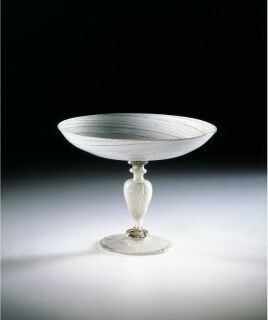Tazza (cup)

Tazza is a type of shallow saucer-like dish mounted on a stem and foot, primarily used during the Renaissance period for presenting sweets or fruits. It originated in Italy and was a popular item of tableware in wealthy households. The tazza reflects the art and culture of its time, often being made of precious materials such as silver, gold, or even porcelain, and frequently decorated with intricate designs, engravings, or paintings.
History[edit]
The tazza became popular in the 15th century, embodying the Renaissance's revival of classical antiquity and its values. It was not only a functional item but also a display of wealth and artistic taste. The design of the tazza, with its classical references, was influenced by the discovery of ancient artifacts during this period. It was common in the courts of Italy, France, and other parts of Europe, where it was used to serve delicacies or as a decorative piece.
Design and Use[edit]
Typically, a tazza consists of a bowl-like top with a wide, open brim, supported by a stem and foot, similar to a goblet but with a broader and shallower bowl. The design allowed for the display of its contents, making it ideal for holding fruits, nuts, or sweets. Tazzas were often part of a larger set of tableware and were used during banquets and special occasions.
In terms of decoration, tazzas were commonly adorned with motifs from nature, mythology, or historical scenes, reflecting the Renaissance's interest in the classical world and its narratives. Craftsmen used various techniques to embellish these pieces, including chasing, enameling, and gem setting.
Materials[edit]
The choice of material for a tazza often indicated the status of its owner. Precious metals like gold and silver were favored by the aristocracy, while the burgeoning middle class might have tazzas made of pewter or ceramic. The introduction of porcelain from China added another luxurious option for the European elite, leading to a surge in porcelain tazzas, especially in the 18th century.
Cultural Significance[edit]
Beyond its practical use, the tazza served as a symbol of hospitality and generosity, embodying the Renaissance ideal of sharing and communal living. It also represented the period's appreciation for beauty and craftsmanship, with each piece reflecting the skill of its maker and the artistic trends of the time.
Modern Times[edit]
Today, antique tazzas are prized by collectors for their historical and artistic value. They are studied by historians and art historians as examples of Renaissance craftsmanship and design. Reproductions are also popular, serving as decorative items that evoke the elegance and style of the past.
Ad. Transform your life with W8MD's Budget GLP-1 injections from $75


W8MD offers a medical weight loss program to lose weight in Philadelphia. Our physician-supervised medical weight loss provides:
- Weight loss injections in NYC (generic and brand names):
- Zepbound / Mounjaro, Wegovy / Ozempic, Saxenda
- Most insurances accepted or discounted self-pay rates. We will obtain insurance prior authorizations if needed.
- Generic GLP1 weight loss injections from $75 for the starting dose.
- Also offer prescription weight loss medications including Phentermine, Qsymia, Diethylpropion, Contrave etc.
NYC weight loss doctor appointmentsNYC weight loss doctor appointments
Start your NYC weight loss journey today at our NYC medical weight loss and Philadelphia medical weight loss clinics.
- Call 718-946-5500 to lose weight in NYC or for medical weight loss in Philadelphia 215-676-2334.
- Tags:NYC medical weight loss, Philadelphia lose weight Zepbound NYC, Budget GLP1 weight loss injections, Wegovy Philadelphia, Wegovy NYC, Philadelphia medical weight loss, Brookly weight loss and Wegovy NYC
|
WikiMD's Wellness Encyclopedia |
| Let Food Be Thy Medicine Medicine Thy Food - Hippocrates |
Medical Disclaimer: WikiMD is not a substitute for professional medical advice. The information on WikiMD is provided as an information resource only, may be incorrect, outdated or misleading, and is not to be used or relied on for any diagnostic or treatment purposes. Please consult your health care provider before making any healthcare decisions or for guidance about a specific medical condition. WikiMD expressly disclaims responsibility, and shall have no liability, for any damages, loss, injury, or liability whatsoever suffered as a result of your reliance on the information contained in this site. By visiting this site you agree to the foregoing terms and conditions, which may from time to time be changed or supplemented by WikiMD. If you do not agree to the foregoing terms and conditions, you should not enter or use this site. See full disclaimer.
Credits:Most images are courtesy of Wikimedia commons, and templates, categories Wikipedia, licensed under CC BY SA or similar.
Translate this page: - East Asian
中文,
日本,
한국어,
South Asian
हिन्दी,
தமிழ்,
తెలుగు,
Urdu,
ಕನ್ನಡ,
Southeast Asian
Indonesian,
Vietnamese,
Thai,
မြန်မာဘာသာ,
বাংলা
European
español,
Deutsch,
français,
Greek,
português do Brasil,
polski,
română,
русский,
Nederlands,
norsk,
svenska,
suomi,
Italian
Middle Eastern & African
عربى,
Turkish,
Persian,
Hebrew,
Afrikaans,
isiZulu,
Kiswahili,
Other
Bulgarian,
Hungarian,
Czech,
Swedish,
മലയാളം,
मराठी,
ਪੰਜਾਬੀ,
ગુજરાતી,
Portuguese,
Ukrainian
